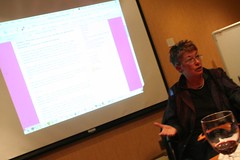Text of presentation at TeachMeet06
Ok. I found the pearls. The twinset eluded me. I’m a recently retired English teacher – and yes, I found the time to explore the uses of blogging once I was out of the classroom, but then no-one had told me what I’m about to tell you. I used a blog to improve the Creative Writing skills of two private students between their Standard Grade prelim and the final exam – and it’s a big task to improve writing in 3 months.
And you might well dismiss what I say because I’m not doing it with a whole class, but I’m not going to be dismissed so easily. That’s because when I was teaching I really worked my socks off on formative assessment. That often meant writing much the same thing on up to 30 essays at a sitting – because as you presumably all know, children tend to make the same mistakes or need the same tips when engaged on a task. And that’s the first thing I’d say about blogging when teaching creative writing: you can blog a point and have all the pupils read it and refer to it when needed – because it’s there for all to see.
Process Writing is a method of encouraging “real” writing – of getting students to open up and express genuine emotions through writing that is at once spontaneous and well-controlled. In the classroom until now, it has involved each student in writing on six small pieces of paper, each following on from an initial idea based on “a place, a person or an object important or familiar to you”. They consult in pairs after each one, then use the ideas generated to build a piece of writing – or to reject everything done so far and start again. After a fortnight of writing and conferencing and editing and redrafting the final piece is written – and then physically cut, using scissors and sellotape. Really.
Are you beginning to see how much tidier – and less noisy – this would be if it were the subject of a class blog? Process Blogging, in fact. This is what I did. The students set up the blog – named it, thought up a user name and password – and they wrote the posts. Each post was identified by the student’s initials or nickname. It might be the opening paragraph of a novel based on the beginning of one of Graham Greene’s stories or a descriptive paragraph trying out the use of effective imagery – or any of the areas explored in Process Writing.
I did most of the commenting – the usual pernickety stuff I’d been accustomed to scribble on their work about comma-splice, layout of dialogue, dead metaphors – you name it. Every thing an English teacher needs to point out, depending on the stage and ability of the student. Sometimes they’d come right back: “What do you mean by comma-splice?” “Why is that a bad word to use there?” Other times there would be a rewrite and :”Is this better?” I’d also suggest prompts – because that’s a big part of the conferencing in Process Writing. So I might ask: “What is the heroine going to do now?” or “You haven’t told me how she got to this stage – put in a paragraph to get her down the road” And they’d do it – perhaps in a five-minute interval after I’d commented.
But I wasn’t alone in the Comments section. Other bloggers joined in – friends of mine, other blog-savvy educators, my former students. So my current pupils realised they had a real audience – not just each other, not just me, but people they didn’t know, “out there”. Their writing became more focused, more intense. They worked on it every day – a little at a time, or a whole essay in a night for a time trial. Often I’d comment on it before I went to bed – a much more instant response than waiting for the English period or till I’d finished the S1 jotters.
And it worked. By the time of the Standard Grade exam, the two girls who’d been disappointed with a level 3 in the prelim both gained Credit grades for writing, and one of them got straight 1s. You can check her response on http://.pinkyparky.blogspot.com - the blog is called Progress Report.
Blogging of itself isn’t the answer to every English teacher’s prayer – a poor teacher or a lazy one is not going to have a miraculous effect simply because he uses a blog. Blogs are merely a tool. But it’s a sad day when good teachers aren’t given access to all the methods available to them – and sadder still when they themselves put up the barriers.
By the way: I have some great ideas about writing Critical Essays using blogs – but they’ll have to wait!
TeachMeet06

Hi Chris,
ReplyDeleteGlad blogging was more inviting than bed. It is very useful to be able to read over what I have already heard.
Process writing chimes with a lot of primary teaching.
I am now worried about comma-splice as I think it is my standard way of writing.
Anyway thanks for sharing a best practice example.
John, comma-splice is like insanity: if you know you've got it, you're not as bad as you think!
ReplyDelete